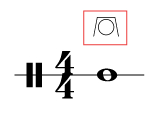Element: percussion
Description

The percussion element is used to define percussion pictogram symbols. Definitions for these symbols can be found in Kurt Stone's "Music Notation in the Twentieth Century" on pages 206-212 and 223. Some values are added to these based on how usage has evolved in the 30 years since Stone's book was published.
Derived By
Type percussion
Attributes
| Name | Type | Required? | Default | Description |
|---|---|---|---|---|
| default-x | tenths | No |
|
|
| default-y | tenths | No |
|
|
| relative-x | tenths | No |
|
|
| relative-y | tenths | No |
|
|
| font-family | comma-separated-text | No |
|
|
| font-style | font-style | No |
|
|
| font-size | font-size | No |
|
|
| font-weight | font-weight | No |
|
|
| color | color | No |
|
|
| halign | left-center-right | No |
|
|
| valign | valign | No | The valign attribute is used to indicate vertical alignment to the top, middle, bottom, or baseline of the text or image. Defaults are implementation-dependent. |
|
| enclosure | enclosure-shape | No |
|
Content Model
Contains elements as defined in the following table.
| Component | Type | Occurs | Default | Description |
|---|---|---|---|---|
 |
1..1 |
|
||
| beater | beater | 1..1 |

The beater type represents pictograms for beaters, mallets, and sticks that do not have different materials represented in the pictogram. |
|
| effect | effect | 1..1 |

The effect type represents pictograms for sound effect percussion instruments. The cannon value is in addition to Stone's list. |
|
| glass | glass | 1..1 |

|
|
| membrane | membrane | 1..1 |

The membrane type represents pictograms for membrane percussion instruments. The goblet drum value is in addition to Stone's list. |
|
| metal | metal | 1..1 |

The metal type represents pictograms for metal percussion instruments. The hi-hat value refers to a pictogram like Stone's high-hat cymbals but without the long vertical line at the bottom. |
|
| other-percussion | xs:string | 1..1 |
|
|
| pitched | pitched | 1..1 |

The pitched type represents pictograms for pitched percussion instruments. The chimes and tubular chimes values distinguish the single-line and double-line versions of the pictogram. The mallet value is in addition to Stone's list. |
|
| stick | stick | 1..1 |

The stick type represents pictograms where the material of the stick, mallet, or beater is included. |
|
| stick-location | stick-location | 1..1 |
|
|
| timpani | empty | 1..1 |

|
|
| wood | wood | 1..1 |

The wood type represents pictograms for wood percussion instruments. The maraca and maracas values distinguish the one- and two-maraca versions of the pictogram. The vibraslap and castanets values are in addition to Stone's list. |
|
Referenced By
- Complex Type direction-type
Example

<direction directive="yes" placement="above">
<direction-type>
<percussion default-y="32" font-size="24" halign="left" relative-x="32">
<metal>tam tam</metal>
</percussion>
</direction-type>
</direction>
